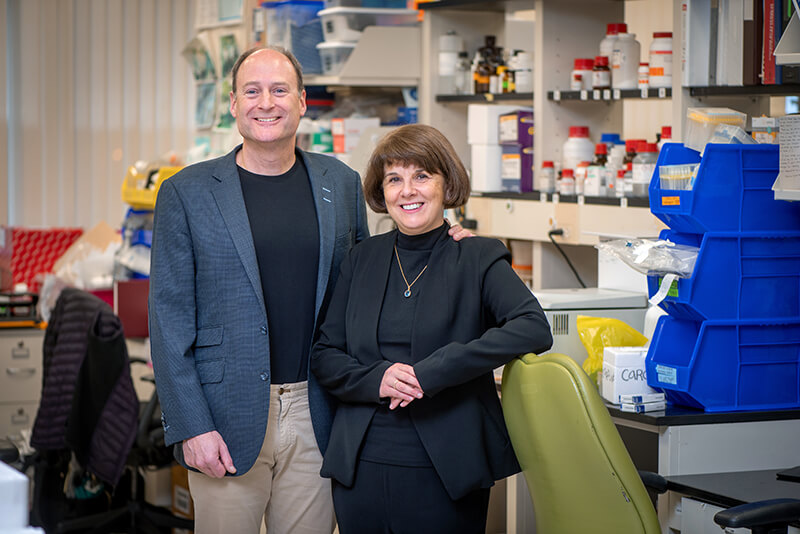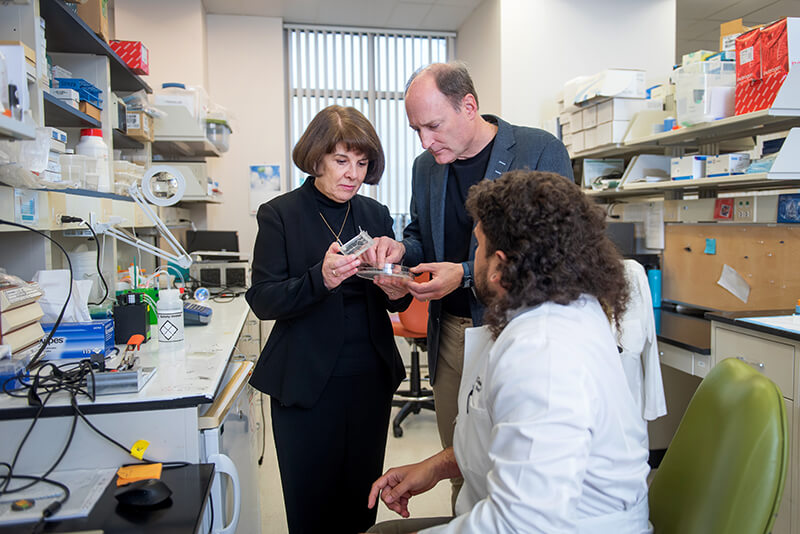Graça Almeida-Porada, MD, PhD, professor at Wake Forest Institute for Regenerative Medicine (WFIRM) and Christopher Porada, PhD, professor at WFIRM, lead the Porada Lab. Not only are they working to advance the outcomes of stem cell transplantation and gene therapy in fetal and neonatal patients with genetic disorders; they’re also working with NASA on how to mitigate the health risks of astronauts and space radiation exposure.

Almeida-Porada leads the Fetal Research and Therapy Program (FRTP) at WFIRM, which is aimed at pursuing basic and translational research to develop prenatal treatment approaches for genetic disorders and other life-threatening conditions. WFIRM is the only center in North Carolina to currently house a research program dedicated to this initiative. One genetic disorder that FRTP is specifically focused on is hemophilia A. Almeida-Porada and her colleagues are exploring the possibility of treating, and even curing this disease, with a combined cell and gene therapy approach before birth.
Porada works in-tandem with Almeida-Porada on the FRTP research while also working with NASA on how astronauts can safely travel into deep space. Radiation exposure is believed to be one of the most dangerous aspects of traveling to space and more specifically, to Mars. Porada and his fellow researchers have identified and are currently testing a common dietary supplement on its ability to protect astronauts from these damaging effects.
Get to know these researchers in their own words.
Tell us about your background. What’s your experience and how did you get into the field?
Graça Almeida-Porada (GAP): I am a hematologist by training and during my clinical work I felt that there weren’t any real solutions for patients with genetic disorders such as hemophilia, sickle cell, thalassemia, storage diseases and so many others. These diseases affect children, and yet the best thing we could offer was a lifetime of treatments, drugs and trips to the hospital.
“I came to the realization that the current state-of-the-art medical treatments just couldn't offer solutions to these patients. It was this realization, coupled with my desire to do research, that motivated me to pursue my PhD and to try and find cures instead of treatments.” – Graça Almeida-Porada, MD, PhD
While I was doing my PhD thesis work, the group next door was pioneering fetal transplants, with the goal of treating patients with genetic disorders and I thought that was a brilliant concept – to treat someone before they were born – so they could be born healthy and have no problems afterwards. I thought if we could get fetal transplantation to work, we could prevent all these kids from having to suffer, not just from the symptoms of their disease, but we could also prevent all the damage that can occur during fetal development, or during infancy, despite the best treatments.
The opportunity to work with that group as a fellow further solidified my determination to continue to work in fetal therapies and led me on the path to what I do right now, which is trying to develop novel approaches to treat genetic disorders in young children or prior to birth.
Christopher Porada (CP): While studying molecular biology as an undergraduate, I became fascinated with the idea that it could one day be possible to manipulate the sequence of the genome and correct mutations that cause human diseases. This led me to pursue a PhD performing research on developing novel approaches to gene therapy, specifically focused on trying to intervene early enough in development that the irreversible damage that occurs in many genetic disorders prior to birth could be avoided. I performed this work under the mentorship of Dr. Esmail Zanjani, one of the pioneers and leaders in the field of fetal therapies.
Hematopoietic stem cells (HSC) are one of the only cells in the body that have the ability to self-renew, making new copies of themselves throughout the entire lifetime of an individual, while simultaneously differentiating to produce all of the mature hematopoietic and immune cells present in the peripheral blood. This makes an ideal target cell type for gene therapy because corrected HSC should, in theory, persist for the lifetime of the patient, producing gene-corrected progeny that enter the bloodstream and circulate throughout all of the tissues of the body, delivering their therapeutic cargo. For this reason, much of my research has focused on developing ways to efficiently transfer genes into HSC.

How does your research improve clinical care?
GAP: By advancing the knowledge and accelerating clinical applications of stem cell transplantation and gene therapy approaches to treat fetuses with congenital disorders, we’re working to transform the paradigm for how patients with genetic disorders are treated, especially if we can provide these patients with a cure. In addition, treating genetic disorders prior to birth can also prevent the damage and alterations that can occur during fetal development.
CP: The ability to cure genetic diseases with a single treatment via gene therapy would completely transform the prototype for how patients with these diseases are treated, dramatically improve their quality of life and life expectancy, and it would greatly lower the costs to the patient, his/her family, and the healthcare system.
What’s your current research focus?
GAP: The current focus of my research continues to be the development of cell and gene therapy platforms to treat patients with genetic disorders prior to birth. We’re currently focused on hemophilia A and sickle cell disease.
In order to ascertain the safety of these therapies, our research also focuses on the use of human organoid platforms with integrated microfluidics that consolidate a variety of important physiological parameters such as 3D architecture, cell-cell/cell-matrix interactions and circulation – this allows for a better mimicry of in vivo conditions, to address the impact and safety of different gene delivery systems.
CP: While a central focus of my research will always be developing gene-based therapies for curing genetic disorders, for the past eight years I have been using my experience with the hematopoietic system to perform NASA-supported studies to understand and define the biological effects that conditions of spaceflight have on the human hematopoietic and immune system. The two spaceflight stressors we are focused on are conditions of weightlessness (microgravity) and space radiation, with an emphasis on determining the risks of hematological malignancies for astronauts who will be part of future planned missions to the moon and ultimately to Mars.
The types of radiation present in deep space do not exist on Earth and as a result, the biological effects of exposure to these unique radiation species are not well understood, making risk estimates very difficult. We are making use of NASA’s Space Radiation Laboratory to perform some of the first studies to define the effects of space radiation on the human hematopoietic system.
We’re also undertaking studies with human organoids to enable us to understand how other major human tissues/organs respond to these exposures and define what risks such exposures may pose. It is hoped our ongoing efforts will better define, characterize, and ultimately mitigate the damaging effects of space radiation on the human hematopoietic system, enabling safe long-duration missions in deep space.
What attributes should someone have that’s pursuing a career in research or healthcare?
GAP: I believe that pursuing a career in research or healthcare is about having perseverance, compassion, selflessness, optimism, and true and relentless passion.
CP: I think to pursue a career in research, one must have a true passion for learning, as your education will never stop. You also need to have a very “thick skin”, as much of the time of a researcher is spent writing grants to secure funding to enable you to perform the studies you wish to perform.
With funding rates between 10-15% at the National Institutes of Health, this means that only roughly 1 in 10 of the proposals you write will be funded. Some opportunities from NASA are only funded at closer to 5%. One must be able to brush off rejection and get right back in there to try again. Given the very long hours that come with a career in research (most evenings and weekends are spent working), one must be hard-working and really enjoy what they do, or they will quickly become burned out and disenchanted with their choice of career.
What’s the most exciting research you’ve worked on?
GAP: Applying new concepts and knowledge from other scientific fields and bringing them to my area of research is what makes me the most excited – the open possibilities. I would say that the most exciting research that I would like to work on, would be applying quantum physics to my area of research. Unfortunately, we did not get funded on that project; so, it was a short-lived excitement…but worth it. I still dream about it!
CP: I think the work that we are currently doing to try to understand the risks to astronauts during missions in deep space beyond the protective cocoon of the Earth’s magnetosphere is very exciting. Being able to travel to the NASA Space Radiation Lab and perform experiments using the beamline coming off of the Relativistic Heavy Ion Collider to obtain heavy ions normally present only in outer space and thereby study their effects on human cells and 3D organoids is truly amazing. Since I was a child, I dreamt of being an astronaut and working for NASA. I consider myself very fortunate to have the chance to use my expertise in molecular biology to help NASA understand the risks to astronauts and ultimately find ways to mitigate these risks and thereby enable safe missions in deep space, such as those NASA has planned to the moon and to Mars.
What advice would you give someone who is just starting their research or medical career?
GAP: Make sure that what you do brings you immense joy and fulfillment, not a job but a calling, and what you do is in the service of others. It’s also important to have a partner who shares or understands your passion and supports what you do, and find a work-life balance that enables you to thrive.
CP: One key component is to have the full support of your spouse/partner in your endeavors. My wife and I have worked together for the past 30 years and run our lab together. Without her constant help, support, encouragement, and brilliant insights, I would certainly not be where I am today.
“Another key to a successful career in research is to be sure that the path you pick enables you to do something you truly love. You are going to spend long hours in the lab and at your computer writing grants and papers, so if you love what you do, this time will be enjoyable and won’t even seem like work.” – Christopher Porada, PhD
What are some of your hobbies or interests outside of work?
GAP: I love all forms or art, but especially painting; I am fascinated by light and how colors are impacted by light and interact on a canvas. I also greatly enjoy radioastronomy, and I find it enthralling to be able to capture and record what we cannot see, the invisible electromagnetic radiation (radio waves). I grew up amongst radio and satellite antennas, so while radioastronomy expands my sense of wonder, it also brings back comforting memories of my childhood and family. Additionally, my husband, our son and I also take much pleasure in going together to Formula 1 races.
CP: I love music and am an avid audiophile, ever striving to find ways to wrest the next level of sonic realism from my stereo system to bring me closer to the live event. I also greatly enjoy astrophotography; I find staring up at the stars to be very peaceful, and I think that trying to capture images of the faintest objects in the distant universe on my computer, objects that are not even visible to the human eye, is very rewarding and truly inspiring.
